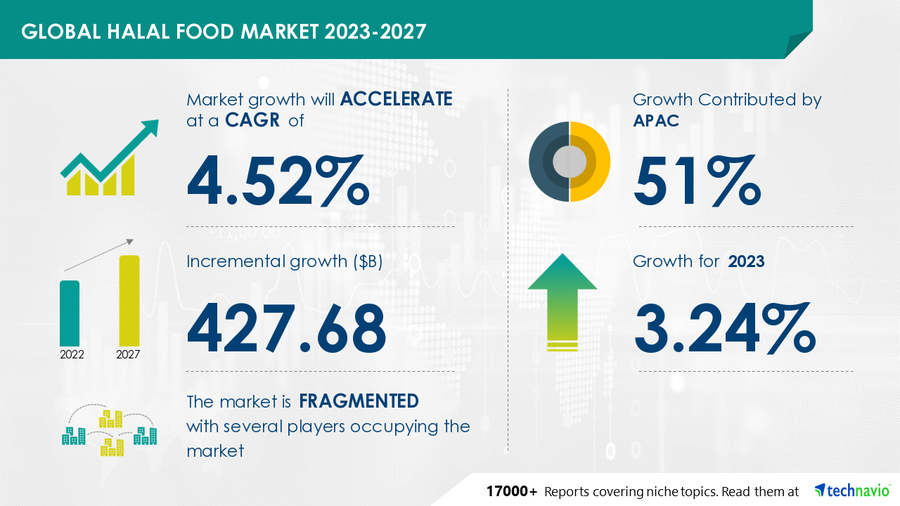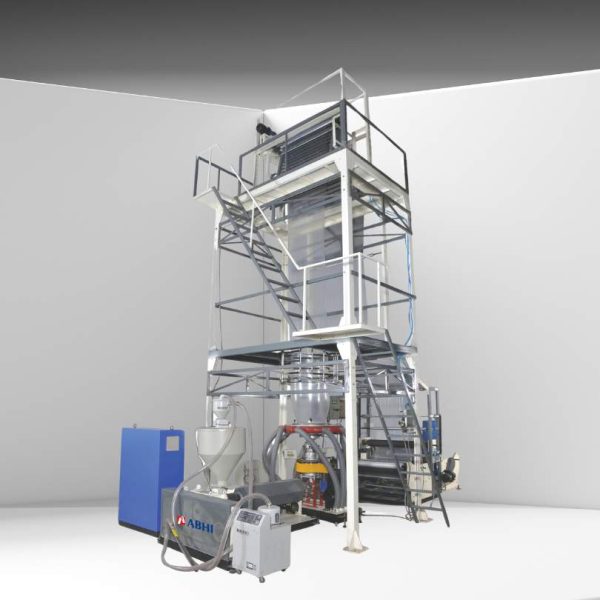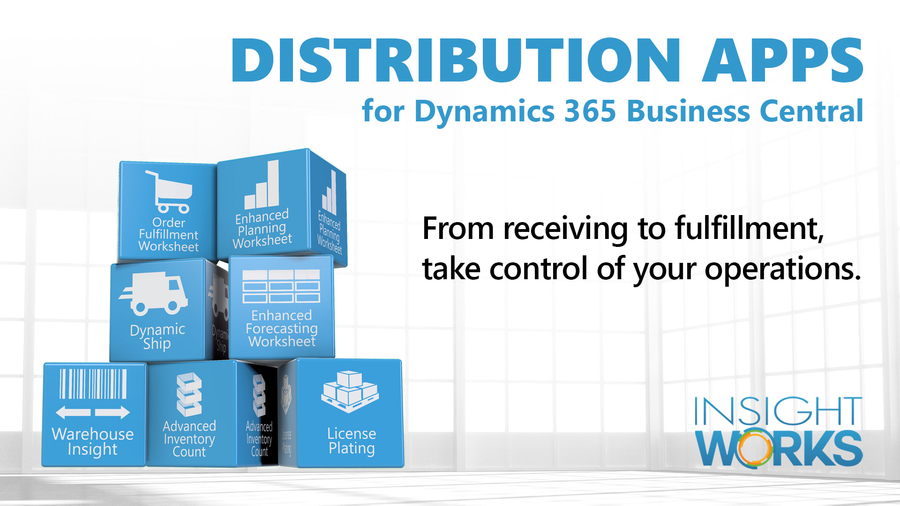Global growth in the commercial sector drives market growth – Technavio
NEW YORK, NY, November 17, 2023 /24-7PressRelease/ — The Halal Food Market size is estimated to grow by USD 427.68 billion from 2022 to 2027, according to Technavio. The market is estimated to grow at a CAGR of almost 4.52% during the forecast period. The growth of the halal food and beverage market is notably driven by the rising consumer spending on these products. In the Countries like Indonesia, Malaysia, Saudi Arabia, Singapore, the UAE, and other Middle Eastern nations, the global halal food market has experienced substantial expansion in recent years. This growth has extended to countries such as the US, Germany, Australia, and India, largely due to increasing consumer awareness of halal food. Australia, a significant global exporter of food and beverages, anticipates a surge in its exports of halal food during the forecast period. APAC held the largest share of the global market in 2022, and the market in the region is estimated to witness an incremental growth of 51%. For more insights on the historic (2017 to 2021) and forecast market size (2023 to 2027) – Request a sample report
What’s New?
• Special coverage on the Russia-Ukraine war; global inflation; recovery analysis from COVID-19; supply chain disruptions, global trade tensions; and risk of recession
• Global competitiveness and key competitor positions
• Market presence across multiple geographical footprints – Strong/Active/Niche/Trivial – buy the report
Halal Food Market – Segmentation Assessment
Segment Overview
Technavio has segmented the market based on product (halal MPS, halal BCC, halal FVN, halal beverages, and others), distribution channel (offline and online), and geography (APAC, North America, Europe, Middle East and Africa, and South America).
The halal food and beverage market, particularly within the halal MPS (Meat, Poultry, and Seafood) segment, is projected to experience significant growth. This segment covers a range of halal foods like beef, lamb, goat meat, chicken, Turkey, and fish. It can be divided into three categories: fresh halal meat, poultry, and seafood; minimally processed options without artificial additives; and heavily processed products like halal sausages, salami, canned and frozen meats.
Geography Overview
By geography, the Halal Food Market is segmented into APAC, Europe, North America, South America, and Middle East and Africa. The report provides actionable insights and estimates the contribution of all regions to the growth of the Halal Food Market
The APAC is expected to contribute 51% to the global market’s growth. Within APAC, countries like the Philippines, Indonesia, Pakistan, Bangladesh, Malaysia, and Singapore stand as significant markets for halal food. The increased spending by consumers on halal food plays a significant role in driving the regional market for halal food and beverages. Notably, major companies have established dedicated facilities for producing halal food in APAC. For instance, Nestle has introduced a variety of halal food products manufactured at its production facility located in Australia.
Insights on the market contribution of various segments including country and region wise, historic (2017 to 2021) and forecast market size (2023 to 2027) – Download a Sample Report
Halal Food Market – Market Dynamics
Key factor driving market growth
• Rising consumer expenditure on halal food globally fuels market growth, expanding beyond traditional markets to countries like the US, Germany, Australia, and India due to increased awareness.
• Australia emerges as a significant global exporter of halal food, with anticipated growth in exports during the forecast period.
• Increased consumer spending on halal food in countries like Indonesia, Malaysia, Turkey, and Singapore, driven by expanded product offerings and a surge in halal food companies, positively influences market growth prospects.
Leading trends influencing the market
The expansion of the organized retail industry significantly impacts the growth of the halal food and beverage market. Hypermarkets and supermarkets serve as primary offline distribution channels for halal foods. Within these channels, organized retail simplifies the purchasing experience for consumers and offers a wide array of halal food products. Anticipated growth in the market during the forecast period is driven by the rise in organized retailers providing their own branded halal food products.
Major challenges hindering the market growth
The absence of universally accepted regulatory standards for halal certification could hinder the growth of the halal food market. Varied country-specific standards and continuously evolving regulatory frameworks set significant challenges to the global halal food market. Regulatory complexities arise due to differences across regions and countries, lacking a viable accreditation scheme to oversee the operations of halal certification bodies worldwide, often experiencing conflicts of interest among them. Presently, the regulatory structure for halal food certification remains specific to individual countries.
Insights on Market Drivers, trends, & Challenges, historic period(2017 to 2021) and forecast period(2023 to 2027)- Request a sample report
What are the key data covered in this Halal Food Market report?
• CAGR of the market during the forecast period
• Detailed information on factors that will drive the growth of the Halal Food Market between 2023 and 2027
• Precise estimation of the size of the Halal Food Market size and its contribution to the market in focus on the parent market
• Accurate predictions about upcoming trends and changes in consumer behaviors
• Growth of the Halal Food Market industry across APAC, Europe, North America, South America, and Middle East and Africa
• A thorough analysis of the market’s competitive landscape and detailed information about vendors
• Comprehensive analysis of factors that will challenge the growth of Halal Food Market vendors
Related Reports:
Kosher Foods Market: Kosher Foods Market size is estimated to grow by USD 12.78 billion between 2022 and 2027 accelerating at a CAGR of 6.36% during the forecast period.
Camel Meat Market: The Camel Meat Market size is projected to increase by USD 100.83 million and the market size is estimated to grow at a CAGR of 6.32% between 2023 and 2028.
TOC
1. Executive Summary
2. Market Landscape
3. Market Sizing
4. Historic Market Size
5. Five Forces Analysis
6. Market Segmentation by Product
7. Market Segmentation by Distribution Channel
8. Customer Landscape
9. Geographic Landscape
10. Drivers, Challenges, and Trends
11. Company Landscape
12. Company Analysis
13. Appendix
About US
Technavio is a leading global technology research and advisory company. Their research and analysis focus on emerging market trends and provide actionable insights to help businesses identify market opportunities and develop effective strategies to optimize their market positions. With over 500 specialized analysts, Technavio’s report library consists of more than 17,000 reports and counting, covering 800 technologies, spanning across 50 countries. Their client base consists of enterprises of all sizes, including more than 100 Fortune 500 companies. This growing client base relies on Technavio’s comprehensive coverage, extensive research, and actionable market insights to identify opportunities in existing and potential markets and assess their competitive positions within changing market scenarios.
—
For the original version of this press release, please visit 24-7PressRelease.com here




